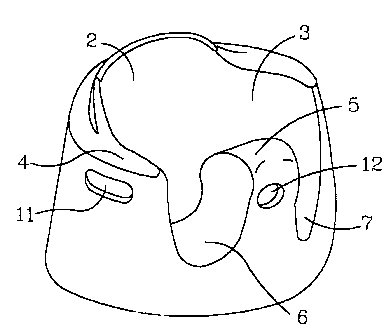Some of the information on this Web page has been provided by external sources. The Government of Canada is not responsible for the accuracy, reliability or currency of the information supplied by external sources. Users wishing to rely upon this information should consult directly with the source of the information. Content provided by external sources is not subject to official languages, privacy and accessibility requirements.
Any discrepancies in the text and image of the Claims and Abstract are due to differing posting times. Text of the Claims and Abstract are posted:
| (12) Patent: | (11) CA 2372064 |
|---|---|
| (54) English Title: | BABY CHAIR |
| (54) French Title: | CHAISE D'ENFANT |
| Status: | Expired and beyond the Period of Reversal |
| (51) International Patent Classification (IPC): |
|
|---|---|
| (72) Inventors : |
|
| (73) Owners : |
|
| (71) Applicants : |
|
| (74) Agent: | NORTON ROSE FULBRIGHT CANADA LLP/S.E.N.C.R.L., S.R.L. |
| (74) Associate agent: | |
| (45) Issued: | 2008-06-10 |
| (86) PCT Filing Date: | 1999-05-04 |
| (87) Open to Public Inspection: | 2000-11-09 |
| Examination requested: | 2004-04-21 |
| Availability of licence: | N/A |
| Dedicated to the Public: | N/A |
| (25) Language of filing: | English |
| Patent Cooperation Treaty (PCT): | Yes |
|---|---|
| (86) PCT Filing Number: | PCT/ZA1999/000030 |
| (87) International Publication Number: | WO 2000065965 |
| (85) National Entry: | 2001-11-02 |
| (30) Application Priority Data: | None |
|---|
A baby supporting chair which
comprises a seat, a brackrest, two
side supports, a front support and
between the front support and the side
supports two grooves for the baby's
legs to project outwardly from the
seat, characterised in that the seat of
the chair is at a level equal to or lower
than the level of the bottoms of the
two grooves.
L'invention concerne une chaise d'enfant comprenant un fond, un dossier, deux appuis latéraux, un appui avant et, entre l'appui avant et les appuis latéraux, deux creux permettant aux jambes de l'enfant de se projeter vers l'extérieur. La chaise d'enfant se caractérise par le fait que le fond de la chaise se trouve à un niveau égal ou inférieur à celui des fonds des deux creux.
Note: Claims are shown in the official language in which they were submitted.
Note: Descriptions are shown in the official language in which they were submitted.

2024-08-01:As part of the Next Generation Patents (NGP) transition, the Canadian Patents Database (CPD) now contains a more detailed Event History, which replicates the Event Log of our new back-office solution.
Please note that "Inactive:" events refers to events no longer in use in our new back-office solution.
For a clearer understanding of the status of the application/patent presented on this page, the site Disclaimer , as well as the definitions for Patent , Event History , Maintenance Fee and Payment History should be consulted.
| Description | Date |
|---|---|
| Time Limit for Reversal Expired | 2018-05-04 |
| Letter Sent | 2017-05-04 |
| Inactive: Late MF processed | 2011-09-06 |
| Letter Sent | 2011-05-04 |
| Inactive: Single transfer | 2008-09-10 |
| Inactive: Correspondence - PCT | 2008-09-10 |
| Grant by Issuance | 2008-06-10 |
| Inactive: Cover page published | 2008-06-09 |
| Inactive: Final fee received | 2008-03-13 |
| Pre-grant | 2008-03-13 |
| Letter Sent | 2008-01-14 |
| Notice of Allowance is Issued | 2007-10-05 |
| Letter Sent | 2007-10-05 |
| Notice of Allowance is Issued | 2007-10-05 |
| Inactive: IPC removed | 2007-10-04 |
| Inactive: Approved for allowance (AFA) | 2007-09-26 |
| Amendment Received - Voluntary Amendment | 2007-05-18 |
| Inactive: S.30(2) Rules - Examiner requisition | 2006-11-20 |
| Letter Sent | 2005-08-03 |
| Reinstatement Requirements Deemed Compliant for All Abandonment Reasons | 2005-07-12 |
| Deemed Abandoned - Failure to Respond to Maintenance Fee Notice | 2005-05-04 |
| Amendment Received - Voluntary Amendment | 2004-06-09 |
| Letter Sent | 2004-05-03 |
| Request for Examination Received | 2004-04-21 |
| Request for Examination Requirements Determined Compliant | 2004-04-21 |
| All Requirements for Examination Determined Compliant | 2004-04-21 |
| Inactive: Office letter | 2003-02-18 |
| Inactive: Applicant deleted | 2003-02-17 |
| Inactive: Correspondence - Formalities | 2002-07-30 |
| Letter Sent | 2002-07-30 |
| Reinstatement Requirements Deemed Compliant for All Abandonment Reasons | 2002-07-17 |
| Deemed Abandoned - Failure to Respond to Maintenance Fee Notice | 2002-05-06 |
| Inactive: Courtesy letter - Evidence | 2002-04-30 |
| Inactive: Cover page published | 2002-04-25 |
| Inactive: Notice - National entry - No RFE | 2002-04-22 |
| Inactive: First IPC assigned | 2002-04-22 |
| Application Received - PCT | 2002-03-14 |
| Application Published (Open to Public Inspection) | 2000-11-09 |
| Abandonment Date | Reason | Reinstatement Date |
|---|---|---|
| 2005-05-04 | ||
| 2002-05-06 |
The last payment was received on 2008-03-10
Note : If the full payment has not been received on or before the date indicated, a further fee may be required which may be one of the following
Please refer to the CIPO Patent Fees web page to see all current fee amounts.
Note: Records showing the ownership history in alphabetical order.
| Current Owners on Record |
|---|
| JONIBACH MANAGEMENT TRUST |
| Past Owners on Record |
|---|
| JOHAN NICOLAAS BUITENDACH |